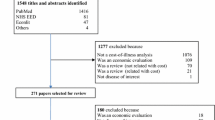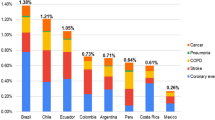Abstract
Purpose
Patients with cardiovascular disease (CVD) or diabetes often require informal care. The burden of informal care, however, was not fully integrated into economic evaluation. We conducted a literature review to summarize the current evidence on economic burden associated with informal care imposed by CVD or diabetes.
Methods
We searched EconLit, EMBASE, and PubMed for publications in English during the period of 1995–2015. Keywords for the search were informal care cost, costs of informal care, informal care, and economic burden. We excluded studies that (1) did not estimate monetary values, (2) examined methods or factors affecting informal care, or (3) did not address CVD or diabetes.
Results
Our search identified 141 potential abstracts, and 10 of the articles met our criteria. Although little research has been conducted, studies used different methods without much consensus, estimates suffered from recall bias, and study samples were small, the costs of informal care have been found high. In 2014 US dollars, estimated additional annual costs of informal care per patient ranged from $1563 to $7532 for stroke, $860 for heart failure, and $1162 to $5082 for diabetes. The total cost of informal care ranged from $5560 to $143,033 for stoke, $12,270 to $20,319 for heart failure, and $1192 to $1321 for diabetes.
Conclusions
The costs of informal care are substantial, and excluding them from economic evaluation would underestimate economic benefits of interventions for the prevention of CVD and diabetes.

Similar content being viewed by others
References
Clark, A. M., et al. (2008). The complex nature of informal care in home-based heart failure management. Journal of Advanced Nursing, 61(4), 373–383.
Evans, R. L., et al. (1992). The family’s role in stroke rehabilitation. A review of the literature. American Journal of Physical Medicine and Rehabilitation, 71(3), 135–139.
Greenwood, N., & Mackenzie, A. (2010). Informal caring for stroke survivors: meta-ethnographic review of qualitative literature. Maturitas, 66(3), 268–276.
Van Houtven, C. H., & Norton, E. C. (2004). Informal care and health care use of older adults. Journal of Health Economics, 23(6), 1159–1180.
Bonsang, E. (2009). Does informal care from children to their elderly parents substitute for formal care in Europe? Journal of Health Economics, 28(1), 143–154.
Charles, K. K., & Sevak, P. (2005). Can family caregiving substitute for nursing home care? Journal of Health Economics, 24(6), 1174–1190.
Bugge, C., Alexander, H., & Hagen, S. (1999). Stroke patients’ informal caregivers. Patient, caregiver, and service factors that affect caregiver strain. Stroke, 30(8), 1517–1523.
Kim, Y., & Schulz, R. (2008). Family caregivers’ strains: comparative analysis of cancer caregiving with dementia, diabetes, and frail elderly caregiving. Journal of Aging and Health, 20(5), 483–503.
Blake, H., Lincoln, N. B., & Clarke, D. D. (2003). Caregiver strain in spouses of stroke patients. Clinical Rehabilitation, 17(3), 312–317.
Li, T. C., et al. (2004). Quality of life of primary caregivers of elderly with cerebrovascular disease or diabetes hospitalized for acute care: assessment of well-being and functioning using the SF-36 health questionnaire. Quality of Life Research, 13(6), 1081–1088.
Low, J. T., Payne, S., & Roderick, P. (1999). The impact of stroke on informal carers: a literature review. Social Science and Medicine, 49(6), 711–725.
Pinquart, M., & Sorensen, S. (2007). Correlates of physical health of informal caregivers: a meta-analysis. The Journals of Gerontology Series B: Psychological Sciences and Social Sciences, 62(2), P126–P137.
Chari, A.V., et al. (2014). The opportunity costs of informal elder-care in the United States: New estimates from the American Time use survey. Health Services Research, 50(3), 871–882.
World Health Organization. Integrated chronic disease prevention and control. http://www.who.int/chp/about/integrated_cd/en/. Cited 2016 October 31.
GBD. (2015). Disease and injury incidence and prevalence collaborators, global, regional, and national incidence, prevalence, and years lived with disability for 310 diseases and injuries, 1990–2015: A systematic analysis for the Global Burden of Disease Study 2015. Lancet, 388(10053), 1545–1602.
World Health Organization. (2016). Global report on diabetes. Geneva, Switzerland: WHO Press.
Writing Group, M., et al. (2016). Heart disease and stroke statistics–2016 update: A report from the American Heart Association. Circulation, 133(4), e38–e360.
World Health Organization (2013). Priority medicines for Europe and the world update report, 2013. In Chapter 6 Priority diseases and reasons for inclusion (Background paper 6). http://www.who.int/medicines/areas/priority_medicines/en/. Cited 2016 October 31.
Dewey, H. M., et al. (2002). Informal care for stroke survivors: results from the North East Melbourne Stroke Incidence Study (NEMESIS). Stroke, 33(4), 1028–1033.
Hickenbottom, S. L., et al. (2002). A national study of the quantity and cost of informal caregiving for the elderly with stroke. Neurology, 58(12), 1754–1759.
Jackson, D., McCrone, P., & Turner-Stokes, L. (2013). Costs of caring for adults with long-term neurological conditions. Journal of Rehabilitation Medicine, 45(7), 653–661.
Joo, H., et al. (2014). Cost of informal caregiving associated with stroke among the elderly in the United States. Neurology, 83(20), 1831–1837.
Riewpaiboon, A., et al. (2009). Economic valuation of informal care in Asia: A case study of care for disabled stroke survivors in Thailand. Social Science and Medicine, 69(4), 648–653.
van den Berg, B., et al. (2006). Economic valuation of informal care: lessons from the application of the opportunity costs and proxy good methods. Social Science and Medicine, 62(4), 835–845.
Delgado, J. F., et al. (2014). Health care and nonhealth care costs in the treatment of patients with symptomatic chronic heart failure in Spain. Revista Española de Cardiologia (English Edition), 67(8), 643–650.
Joo, H., et al. (2015). Cost of informal caregiving for patients with heart failure. American Heart Journal, 169(1), 142 e2–148 e2.
Chatterjee, S., et al. (2011). Cost of informal care for diabetic patients in Thailand. Primary Care Diabetes, 5(2), 109–115.
Langa, K. M., et al. (2002). Informal caregiving for diabetes and diabetic complications among elderly Americans. Journals of Gerontology Series B: Psychological Sciences and Social Sciences, 57(3), S177–S186.
Allen, R. S., et al. (2002). Pain reports by older hospice cancer patients and family caregivers: the role of cognitive functioning. Gerontologist, 42(4), 507–514.
Moudouni, D. K. M., et al. (2012). The relationship between formal and informal care among adult Medicaid personal care services recipients. Health Services Research, 47(4), 1642–1659.
Funding
No external funding sources.
Author information
Authors and Affiliations
Corresponding author
Ethics declarations
Conflict of interest
The authors declare that they have no conflict of interest.
Ethical approval
This article does not contain any studies with human participants or animals performed by any of the authors. For this type of study formal consent is not required.
Appendix 1: Adjustment of informal care hours and costs
Appendix 1: Adjustment of informal care hours and costs
We examined weekly informal care hours and annual informal care costs. When a study provided only monthly or annual informal care hours, we derived weekly informal care hours by dividing monthly informal care hours by 4.3 weeks/month or dividing annual informal care hours by 52 weeks/year. In the same way, when a study provided only weekly or monthly costs of informal care, we derived annual costs of informal care by multiplying weekly costs of informal care by 52 weeks/year or multiplying monthly costs of informal care by 12 months/year.
For comparison, we adjusted informal care cost into 2014 US dollars with the following equation:
Consumer price indices (CPI) of each study country were from the World Bank, and purchasing power parity (PPP) exchange rates were from the Organisation for Economic Co-operation and Development (OECD). For Thailand, which is not a member of OECD, we used the PPP conversion factor from the World Bank.
Rights and permissions
About this article
Cite this article
Joo, H., Zhang, P. & Wang, G. Cost of informal care for patients with cardiovascular disease or diabetes: current evidence and research challenges. Qual Life Res 26, 1379–1386 (2017). https://doi.org/10.1007/s11136-016-1478-0
Accepted:
Published:
Issue Date:
DOI: https://doi.org/10.1007/s11136-016-1478-0




